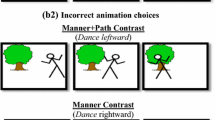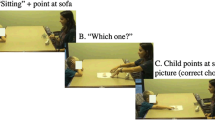Abstract
In past studies, different kinds of gestures have shown different developmental trajectories, with iconic gestures being acquired after words and other gestures before. Similarly, when speech is missing or weak, iconic gestures are rarely used in compensation. These results suggest that iconic gestures are less independent of speech than other kinds of gestures. The present study tested this idea in French-English bilingual children who showed unequal proficiency in their two languages. Eight children between the ages of 3;6 and 4;11 were videotaped in two separate free-play sessions, one in each language. Their use of gestures was coded. The results showed that the children used a higher rate of iconics in their more proficient language but the use of other kinds of gestures did not differ by proficiency. These results suggest that the relationship between iconic gestures and speech is closer than that of other kinds of gestures with speech and cannot therefore be used in the preschool years as a compensatory strategy for weak proficiency.
Similar content being viewed by others
References
Acredolo, L. P., & Goodwyn, S. W. (1985). Symbolic gesturing in language development. Human Development, 28, 40-49.
Acredolo, L. P., & Goodwyn, S. (1988). Symbolic gesturing in normal infants. Child Development, 59, 4450-466.
Alibali, M. W., Kita, S., & Young, A. J. (2000). Gesture and the process of speech production: We think, therefore we gesture. Language and Cognitive Processes, 15, 593-613.
Bates, E., Benigni, L., Bretherton, I., Camaioni, L. & Volterra, V. (1979). The emergence of symbols: Cognition and communication in infancy. New York: Academic Press.
Bates, E., Bretherton, I., Snyder, L., Shore, C., & Volterra, V. (1980). Vocal and gestural symbols at 13 months. Merrill-Palmer Quarterly, 26, 407-423.
Bates, E., Thal, D., Whitesell, K., Fenson, L., & Oakes, L. (1989). Integrating language and gesture in infancy. Developmental Psychology, 25, 1004-1019.
Beattie, G., & Shovelton, H. (2000). Iconic hand gestures and the predictability of words in context in spontaneous speech. British Journal of Psychology, 91, 473-491.
Bermejo Berros, J. (1993). La représentation gestuelle d'actions au cours de l'enfance. L'Année psychologique, 93, 31-57.
Blake, J. (2000). Routes to child language: Evolutionary and developmental precursors. Cambridge: Cambridge University Press.
Bloom, P. (2000). How children learn the meanings of words. Cambridge, MA: MIT Press.
Broca, P. (1861). Nouvelle observation d'aphémie produite par une lésion de la moitié postérieure des deuxième et troisième circonvolutions frontales. Aphémie, 398-407.
Butterworth, G., & Grover, L. (1999). The origins of referential communication in human infancy. In P. Lloyd & C. Fernyhough (eds.), Lev Vygotsky: Critical assessments, Volume II: Thought and language (pp. 3-30). London: Routledge.
Caselli, M. C. (1990). Communicative gestures and first words. In V. Volterra & C. J. Erting (Eds.), From gesture to language in hearing and deaf children (pp. 56-67). Berlin: Springer-Verlag.
Cassell, J., McNeill, D., & McCullough, K. E. (1999). Speech-gesture mismatches: Evidence for one underlying representation of linguistic and nonlinguistic information. Pragmatics and Cognition, 7, 1-33.
Cohen, R. L., & Borsoi, D. (1996). The role of gestures in description-communication: A crosssectional study of aging. Journal of Nonverbal Behavior, 20, 45-63.
De Villiers, J., Bibeau, L., Ramos, E., & Gatty, J. (1993). Gestural communication in oral deaf mother-child pairs: Language with a helping hand? Applied Psycholinguistics, 14, 319-347.
Dunn, L. M., & Dunn, L. M. (1997). Peabody Picture Vocabulary Test, third edition. Circle Pines, MN: American Guidance Service.
Feyereisen, P., & van der Linden, M. (1997). Immediate memory for different kinds of gestures in younger and older adults. CPC, 16, 519-533.
Frick-Horbury, D., & Guttentag, R. E. (1998). The effects of restricting hand gesture production on lexical retrieval and free recall. American Journal of Psychology, 1, 43-62.
Genesee, F., Nicoladis, E., & Paradis, J. (1995). Language differentiation in early bilingual development. Journal of Child Language, 22, 611-631.
Goldin-Meadow, S. (2000). Beyond words: The importance of gesture to researchers and learners. Child Development, 71, 231-239.
Goldin-Meadow, S., & Morford, M. (1985). Gesture in early child language: Studies of deaf and hearing children. Merrill-Palmer Quarterly, 31, 145-176.
González, A. M. (1996). El acceso al sistema lingüístico por parte del niño preescolar sordo. Un estudio evolutivo. Infancia y Aprendizaje, 76, 59-68.
Guidetti, M. (2001). How the study of conventional gestures can contribute to our understanding of early lexicon. Paper presented at Early Language Acquisition in Lyons, France. December.
Gullberg, M. (1999). Communication strategies, gestures, and grammar. Acquisition et Interaction en Langue Etrangère, Proceedings of 8th EUROSLA Conference Paris. Volume 2 (pp. 61-71).
Hadar, U., & Yadlin-Gedassy, S. (1994). Conceptual and lexical aspects of gesture: Evidence from aphasia. Journal of Neurolinguistics, 8, 57-65.
Hanlon, R. E., Brown, J. W., & Gerstman, L. J. (1990). Enhancement of naming in nonfluent aphasia through gesture. Brain and Language, 38, 298-314.
Kelly, S. D., & Church, R. B. (1998). A comparison between children's and adults' ability to detect conceptual information conveyed through representational gestures. Child Development, 69, 85-93.
Kendon, A. (1994). Do gestures communicate?: A review. Research on Language and Social Interaction, 27, 175-200.
Kita, S. (2000). How representational gestures help speaking. In D. McNeill (Ed.), Language and gesture (pp. 162-185). Cambridge: Cambridge University Press.
Kita, S., & Ozyurek, A. (under review). What does cross-linguistic variation in semantic coordination of speech and gesture reveal? Evidence for an interface representation of spatial thinking and speaking.
Krauss, R. M. (1998). Why do we gesture when we speak? Current Directions in Psychological Science, 7, 54-60.
MacWhinney, B. (2000). The CHILDES project (3rd edition). Volume 1: Tools for analyzing talk: Transcription format and programs. Mahwah, NJ: Lawrence Erlbaum.
Masur, E. F. (1982). Mothers' responses to infants' object-related gestures: Influences on lexical development. Journal of Child Language, 9, 23-30.
Masur, E. F. (1983). Gestural development, dual-directional signaling, and the transition to words. Journal of Psycholinguistic Research, 12, 93-109.
McNeill, D. (1985). So you think gestures are nonverbal? Psychological Review, 92, 350-371.
McNeill, D. (1992). Hand and mind: What gestures reveal about thought. Chicago: Chicago University Press.
Nicoladis, E., & Genesee, F. (1996). Bilingual communication strategies and language dominance. In A. Stringfellow, D. Cahana-Amitay, E. Hughes, & A. Zukowski (Eds.), Proceedings of the 20th Annual Boston University Conference on Language Development (pp. 518-527). Somerville, MA: Cascadilla Press.
Nicoladis, E., & Genesee, F. (1997). The role of gesture in young bilingual children's communication with a monolingual stranger. Paper presented at the International Symposium on Bilingualism, Newcastle-upon-Tyne, England. April 10.
Nicoladis, E., Mayberry, R. I., & Genesee, F. (1999). Gesture and early bilingual development. Developmental Psychology, 35, 514-526.
O'Reilly, A. W., Painter, K. M., & Bornstein, M. H. (1997). Relations between language and symbolic gesture development in early childhood. Cognitive Development, 12, 185-197.
Riseborough, M. G. (1982). Meaning in movement: An investigation into the interrelationship of physiographic gestures and speech in seven-year-olds. British Journal of Psychology, 73, 497-503.
Sherman, J., & Nicoladis, E. (2001). What's the difference between gestures in L1 and L2? Poster presented at the Canadian Psychological Association. Ste.-Foy, Quebec. June, 2001.
Thompson, L. A. (1995). Encoding and memory for visible speech and gestures: A comparison between young and older adults. Psychology and Aging, 10, 215-228.
Wilkins, D. P. (2002). Learning to point the Arrernte way. Paper presented at the Child Language Research Forum, Stanford, California, April 13, 2002.
Zinober, B., & Martlew, M. (1985). The development of communicative gestures. In M. D. Barrett (Ed.), Children's single-word speech (pp. 183-215). Chichester, England: Wiley.
Author information
Authors and Affiliations
Rights and permissions
About this article
Cite this article
Nicoladis, E. Some Gestures Develop in Conjunction with Spoken Language Development and Others Don't: Evidence from Bilingual Preschoolers. Journal of Nonverbal Behavior 26, 241–266 (2002). https://doi.org/10.1023/A:1022112201348
Issue Date:
DOI: https://doi.org/10.1023/A:1022112201348




